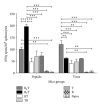B epitope multiplicity and B/T epitope orientation influence immunogenicity of foot-and-mouth disease peptide vaccines
- PMID: 24454475
- PMCID: PMC3878600
- DOI: 10.1155/2013/475960
B epitope multiplicity and B/T epitope orientation influence immunogenicity of foot-and-mouth disease peptide vaccines
Abstract
Synthetic peptides incorporating protective B- and T-cell epitopes are candidates for new safer foot-and-mouth disease (FMD) vaccines. We have reported that dendrimeric peptides including four copies of a B-cell epitope (VP1 136 to 154) linked to a T-cell epitope (3A 21 to 35) of FMD virus (FMDV) elicit potent B- and T-cell specific responses and confer protection to viral challenge, while juxtaposition of these epitopes in a linear peptide induces less efficient responses. To assess the relevance of B-cell epitope multivalency, dendrimers bearing two (B2T) or four (B4T) copies of the B-cell epitope from type O FMDV (a widespread circulating serotype) were tested in CD1 mice and showed that multivalency is advantageous over simple B-T-epitope juxtaposition, resulting in efficient induction of neutralizing antibodies and optimal release of IFN γ . Interestingly, the bivalent B2T construction elicited similar or even better B- and T-cell specific responses than tetravalent B4T. In addition, the presence of the T-cell epitope and its orientation were shown to be critical for the immunogenicity of the linear juxtaposed monovalent peptides analyzed in parallel. Taken together, our results provide useful insights for a more accurate design of FMD subunit vaccines.
Figures





References
-
- James AD, Rushton J. The economics of foot and mouth disease. Revue Scientifique et Technique. 2002;21(3):637–644. - PubMed
-
- Valarcher J-F, Leforban Y, Rweyemamu M, et al. Incursions of foot-and-mouth disease virus into Europe between 1985 and 2006. Transboundary and Emerging Diseases. 2008;55(1):14–34. - PubMed
-
- Sumption K, Rweyemamu M, Wint W. Incidence and distribution of foot-and-mouth disease in Asia, Africa and South America; Combining expert opinion, official disease information and livestock populations to assist risk assessment. Transboundary and Emerging Diseases. 2008;55(1):5–13. - PubMed
-
- Rodriguez LL, Gay CG. Development of vaccines toward the global control and eradication of foot-and-mouth disease. Expert Review of Vaccines. 2011;10(3):377–387. - PubMed
-
- Doel TR. FMD vaccines. Virus Research. 2003;91(1):81–99. - PubMed
Publication types
MeSH terms
Substances
LinkOut - more resources
Full Text Sources
Other Literature Sources
Molecular Biology Databases

